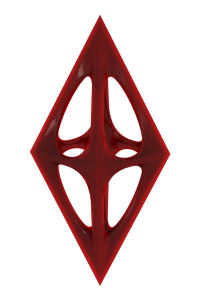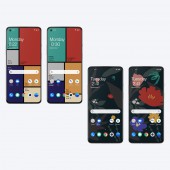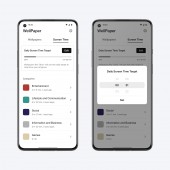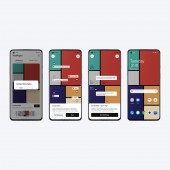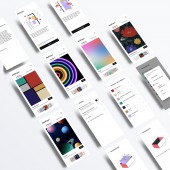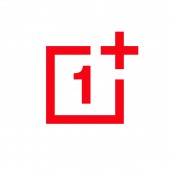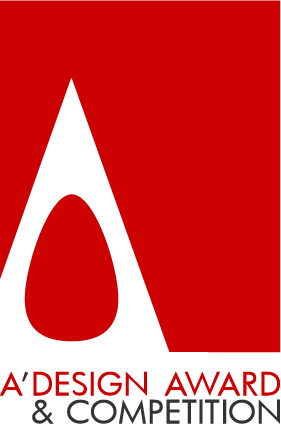Wellpaper Mobile Application by Oneplus Usa |
Home > Winners > #132654 |
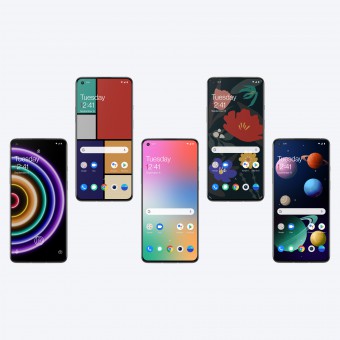 |
|
||||
| DESIGN DETAILS | |||||
| DESIGN NAME: Wellpaper PRIMARY FUNCTION: Mobile Application INSPIRATION: During the pandemic, screen times have increased, especially on mobile devices. Alongside that, there has been an increase in usage of tools for digital wellbeing such as Insight AOD or Zen Mode previously built by OnePlus. Both Android and iOS operating systems have their own digital wellbeing sections, but from user research, we discovered that users rarely use these stock tools since they are hidden in the settings - a place rarely visited - and the charts and lists are simply unattractive. We focus on addressing two increasing user needs in this project: 1. To support smartphone users' increasing need for device personalization. Since the wallpapers are generated from the users' own data, it has a strong personal connection and is different (almost) every time they unlock their devices. 2. To help smartphone users better understand and manage their daily screen time in an effortless way. The wallpapers contain a good amount of information and don't require users to go to the "Digital Wellbeing" section deeply buried in system settings. We also looked into the competitors in the market. This included the stock digital wellbeing apps in iOS and Android, and third-party tools like "Activity Bubbles" and "Screen Stopwatch" by Google Creative Lab. We learned that our solution needs to be accurate, provide enough detail but also easy to understand, and support the increasing need for device personalization. Based on our previous experience building Insight AOD and Zen Mode, we thought a wallpaper could be a desirable medium to check all the boxes without being disruptive. UNIQUE PROPERTIES / PROJECT DESCRIPTION: WellPaper is a mobile app that display's users' screen time and smartphone usage through five creative and dynamic wallpapers. The existing screen time monitoring tools are bland and uninspiring to the user, or deeply hidden in the settings, giving users little reason to return to use the information. WellPaper organizes all installed apps into six categories and tracks their screen times, allowing users to visualize and better understand their day-to-day smartphone habits in an aesthetic way right on the home screen. Users can choose from 5 distinctive wallpaper designs: Composition - Inspired by Piet Mondrian's "Composition No. II," this data-heavy design consists of a range of tiles that constantly scale based on app usage. Glow - A cyberpunk design with six neon rings that get thicker when you are approaching the daily screen time target. Radial - A soft and smooth color gradient on a white canvas, for those who appreciate a minimal design style. Cosmos - A dark-themed solar system design, this wallpaper features 6 planets that constantly scale based on the screen time of the 6 categories. Botanical garden - Inspired by Alex Katz's painting "Tulips 4," comes with a relaxing flower design that lets users' digital wellbeing blossom. Liven up your home screen whilst improving your digital wellbeing with WellPaper. OPERATION / FLOW / INTERACTION: Users start with an onboarding process that introduces the core features, terms and conditions, and asks for access to app usage data. Upon granting access, users proceed to the home screen to see all the five wallpaper designs. Users can select a wallpaper to view an introduction of its design and interaction, then set it as the system wallpaper. Back to the home screen, users can swipe left to see the Screen Time tab, which contains the daily screen time target and all six app categories. The default daily screen time target is set to 3.5 hours based on statistics and the users can change it anytime. The list of app categories below indicates the relationship between six app categories and six colors in the wallpaper, this relationship changes a little bit depending on users' current wallpaper selection. Tapping into one category, users are able to see app the apps belonging and their detailed screen time. Users can also navigate to the settings page from the home page to change the category information of an app, or disable the screen time display when they tap on the wallpaper. PROJECT DURATION AND LOCATION: The project started in May 2021 and finished in September 2021 in New York City, USA. Our global team is based across Shenzhen, Taipei, Hydrabad, London, and New York. During this time we did not meet in person at all and conducted everything virtually. |
PRODUCTION / REALIZATION TECHNOLOGY: After the user research and competitive analysis, the design team actively sought inspiration from different channels to satisfy the different tastes of Android users. From analyzing popular wallpaper apps on the Play Store, to looking into the trending movies and games, then to visiting museums in the New York City including MoMA and the MET, we had concluded eight distinctive directions. We sent the design concepts to OnePlus tester community and internal employees to get feedback, and eventually picked three concepts, Composition, Glow, and Radial to develop in the first season, Cosmos and Botanical Garden for the second season. At the same time, we were designing the mobile app. Serving as a supportive role, the app allows users to explore different wallpapers, understand their interactions, view a comprehensive list of apps' screen time, or even set their daily screen time targets. To have advantages in feature comprehensiveness, wallpaper visual design, and user customization compared to competitors, we organized several usability testing sessions to validate the design and uploaded the app to the Play Store for additional user feedback and bug reports. At a late stage, we added highly requested features including reassigning an app's category and assigning side-loaded apps to categories and continued to iterate the visual design to match the latest Material Design Guidelines. SPECIFICATIONS / TECHNICAL PROPERTIES: High battery consumption is always the major concern people have on live wallpapers. To address this concern, WellPaper uses the screen time of six app categories to calculate and render a static wallpaper, then update it upon unlocks rather than always running in the background. There is also a frequency limit of five minutes to avoid frequent unlocks. In this way, WellPaper is able to provide the visual perk of a dynamic wallpaper, but greatly reduces the battery consumption to a level that is close to the static wallpaper. TAGS: Digital Wellbeing, Wallpaper, Android, Customization, Mobile Application RESEARCH ABSTRACT: During the design phase, we launched a survey to prioritize the 5 design styles we had. The survey was designed using the MaxDiff method on Google form, and Excel was used for analyzing. It was launched in the internal team and the OnePlus Beta Testing users and received 138 valid responses. It turned out that users preferred the more aesthetic styles over the functional ones. Based on the result, we clarified the product strategy to ensure the usability of wallpapers before adding extra values and decided to prioritize the two styles called Radial and Composition which were best received. CHALLENGE: The development team used Android Canvas to develop the wallpapers but it has limits in creating the shadow and blur effects. While the developers used the radial color with a large radius to simulate the blur effect, designers exported multiple sets of assets to represent different stages of the dynamic wallpaper. The team was able to realize 85% of the original wallpaper design through this collaboration. ADDED DATE: 2021-11-02 19:06:12 TEAM MEMBERS (9) : Mingxiao Hu, Yichen Wang, Soojin Park, Jie Qian, MinYen Hsieh, Sam Twist, Andi Lawley, Avinash Chitturi and Sagare Chetan Basawaraj IMAGE CREDITS: ONEPLUS USA Corp. PATENTS/COPYRIGHTS: ONEPLUS USA Corp. |
||||
| Visit the following page to learn more: https://www.onelab.studio/work/wellpaper | |||||
| AWARD DETAILS | |
 |
Wellpaper Mobile Application by Oneplus Usa is Winner in Mobile Technologies, Applications and Software Design Category, 2021 - 2022.· Read the interview with designer Oneplus Usa for design Wellpaper here.· Press Members: Login or Register to request an exclusive interview with Oneplus Usa. · Click here to register inorder to view the profile and other works by Oneplus Usa. |
| SOCIAL |
| + Add to Likes / Favorites | Send to My Email | Comment | Testimonials | View Press-Release | Press Kit |
Did you like Oneplus Usa's Mobile Design?
You will most likely enjoy other award winning mobile design as well.
Click here to view more Award Winning Mobile Design.

